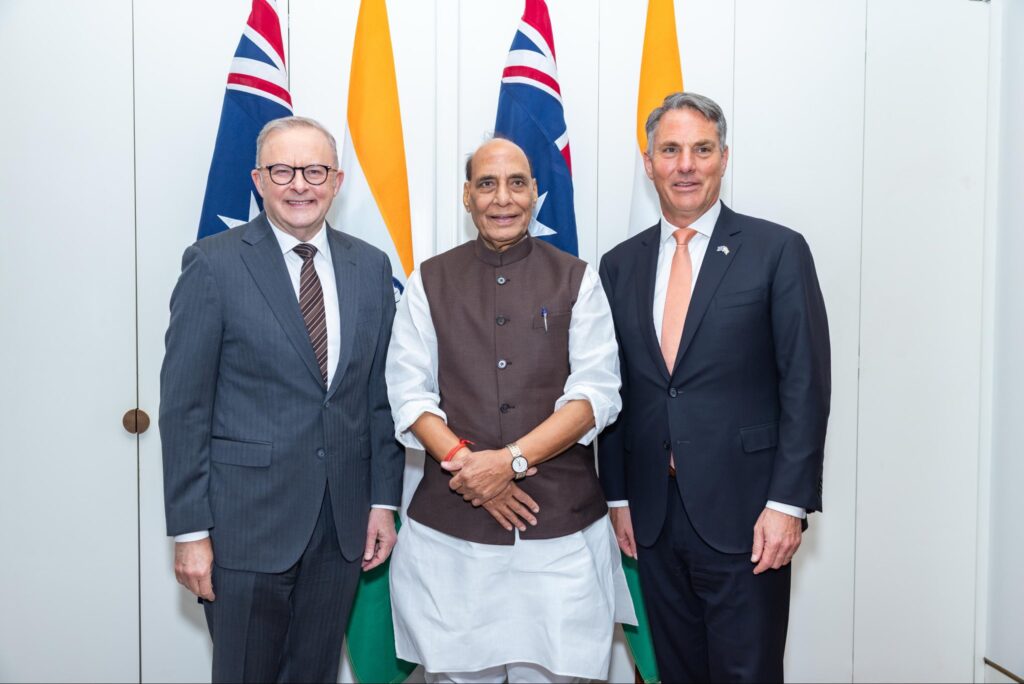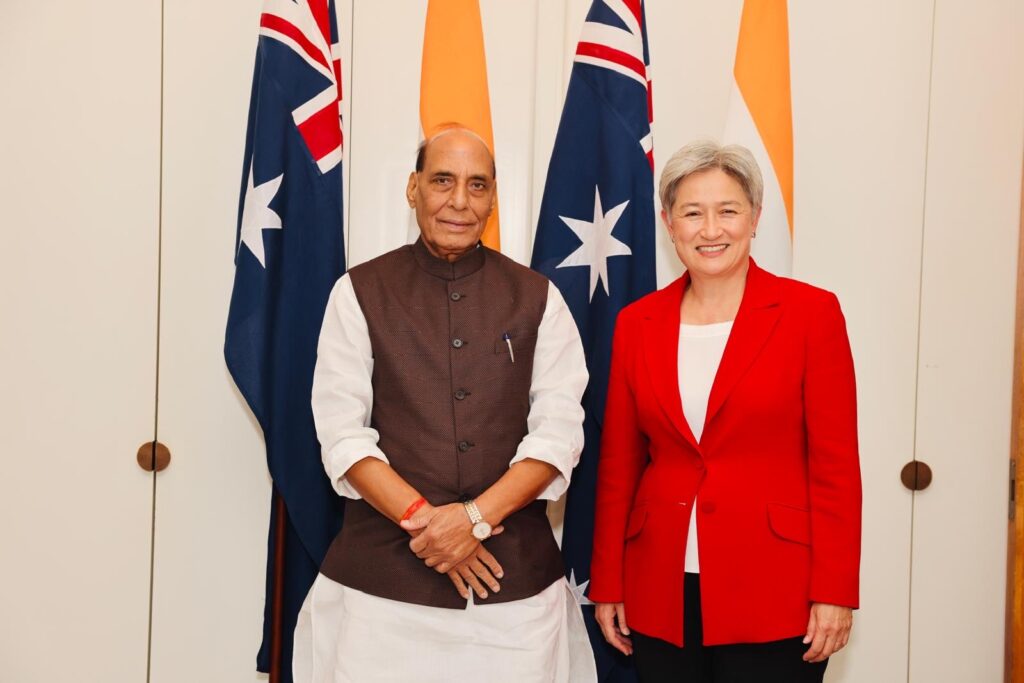Australia and India have taken a major step in strengthening their strategic partnership, signing three landmark defense cooperation agreements on October 9, 2025, during Indian Defense Minister Rajnath Singh’s two-day official visit to Australia.
The visit followed Australian Deputy Prime Minister and Defense Minister Richard Marles’ trip to New Delhi in June 2025, which coincided with the fifth anniversary of the India–Australia Comprehensive Strategic Partnership (CSP). It underscored the growing strategic alignment between the two Indo-Pacific democracies.

In a series of high-level meetings, Singh met with Marles for the Inaugural Australia–India Defense Ministers’ Dialogue at Parliament House. The two ministers signed three key defense cooperation documents during the dialogue held at Parliament House:
- Agreement on Information Sharing
- Memorandum of Understanding on Submarine Search and Rescue Cooperation
- Terms of Reference for establishing Joint Staff Talks
According to Singh, these pacts “aim to enhance operational coordination, maritime security collaboration, and interoperability between the two-armed forces.” He added that discussions covered “defense industry cooperation, cyber defense, military exercises, science and technology collaboration, and multilateral engagement,” highlighting India’s “stature as a credible source of high-quality defense technology globally.”
Singh arrived first in Sydney, where he was formally received by India’s High Commissioner to Australia, Gopal Baglay, before travelling to Canberra aboard a Royal Australian Air Force KC-30A multirole tanker transport aircraft. During the flight, he witnessed an air-to-air refueling demonstration of an F-35 fighter jet, following the 2024 agreement allowing reciprocal air-to-air refueling between their armed forces.

Upon arrival at Canberra’s Royal Australian Air Force Base, he was welcomed by Peter Khalil, Australia’s Assistant Minister for Defense, and later at Parliament House with the traditional Welcome to Country ceremony. The ceremony included a smoking ritual, acknowledging the Aboriginal and Torres Strait Islander peoples, the traditional custodians of the land and symbolizing spiritual cleansing, protection, and their deep ancestral connection to Country.
Singh thanked his counterpart for the warm hospitality and described the ceremony as “a reflection of the commitment India and Australia share to civilizational values and respect for diversity.”
The roundtable began with brief remarks from both ministers during an open media session, followed by closed-door discussions. Marles welcomed Singh, saying, “Our relationship with India is very close; we have long and genuine connections and much in common, from our shared passion for cricket to our growing strategic alignment.” He noted that the dialogue would now become an annual meeting, with the next session to be held in India.

Singh observed that over the past three years, “we have made significant strides in our defense cooperation,” including frequent naval exchanges that underscore “India’s commitment to peace, stability and security in the Indo-Pacific region.” He referred to India’s vision of Mahasagar, “mutual and holistic advancement for security and growth.”
He also noted that bilateral trade had “surged since the 2022 Economic Cooperation and Trade Agreement (ECTA), boosting investments in renewable energy and agriculture,” and that both sides were working to finalize the broader Comprehensive Economic Cooperation Agreement (CECA). Singh highlighted the Indian diaspora’s contribution to Australian society and said that educational and cultural exchanges “bring our democracies closer,” reaffirming that the partnership is “grounded in shared values of freedom, mutual respect and regional peace.”
He also underlined opportunities for Australian companies to collaborate in India’s self-reliance framework (Atmanirbhar Bharat), particularly in defense technology, co-development, and industrial partnerships. Singh said joint efforts in counter-terrorism, cyber security and humanitarian assistance had strengthened both nations’ resilience to emerging challenges.
Calling the talks “timely,” Singh observed that “this meeting comes at a crucial juncture when the world witnesses prolonged conflicts, tensions and cross-border terrorism.” He reiterated India’s “steadfast pursuit of peaceful solutions for protecting sovereignty” and expressed gratitude for “Australia’s unwavering support.”

Marles described the discussions as “a productive meeting at the Inaugural Australia–India Defense Ministers’ Dialogue,” noting that it was “the first time in 12 years that an Indian Defense Minister has visited Australia.” He said both sides agreed “to boost dialogue, cooperation, and complexity in joint and multilateral exercises across the services,” reaffirming their Comprehensive Strategic Partnership.
During his visit, Singh also met with Australia’s Foreign Minister, Penny Wong, and Prime Minister Anthony Albanese, who “fondly recalled his deep association with India.” Singh expressed confidence that the “India–Australia bilateral relationship will continue to grow stronger.”
Earlier in the day, Singh paid homage at the Australian War Memorial in Canberra, describing it as “a tribute to the courage and sacrifice in defense of the values of freedom and democracy that our two countries cherish.” He also honored the memory of Indian soldiers who fought alongside their Australian comrades, noting that their shared sacrifice “reflects an enduring legacy that binds India and Australia through shared values and history.”
The visit builds upon a series of recent defense cooperation milestones, including the 2020 Mutual Logistics Support Arrangement (MLSA) and the 2024 air-to-air refueling agreement.
According to The Lowy Institute, the visit “marks a significant step towards embedding operational coordination rather than symbolic alignment” between India and Australia. The think tank noted that both nations have spent five years developing a framework for practical defense collaboration, including joint maritime exercises and enhanced information sharing in the Indo-Pacific region.






